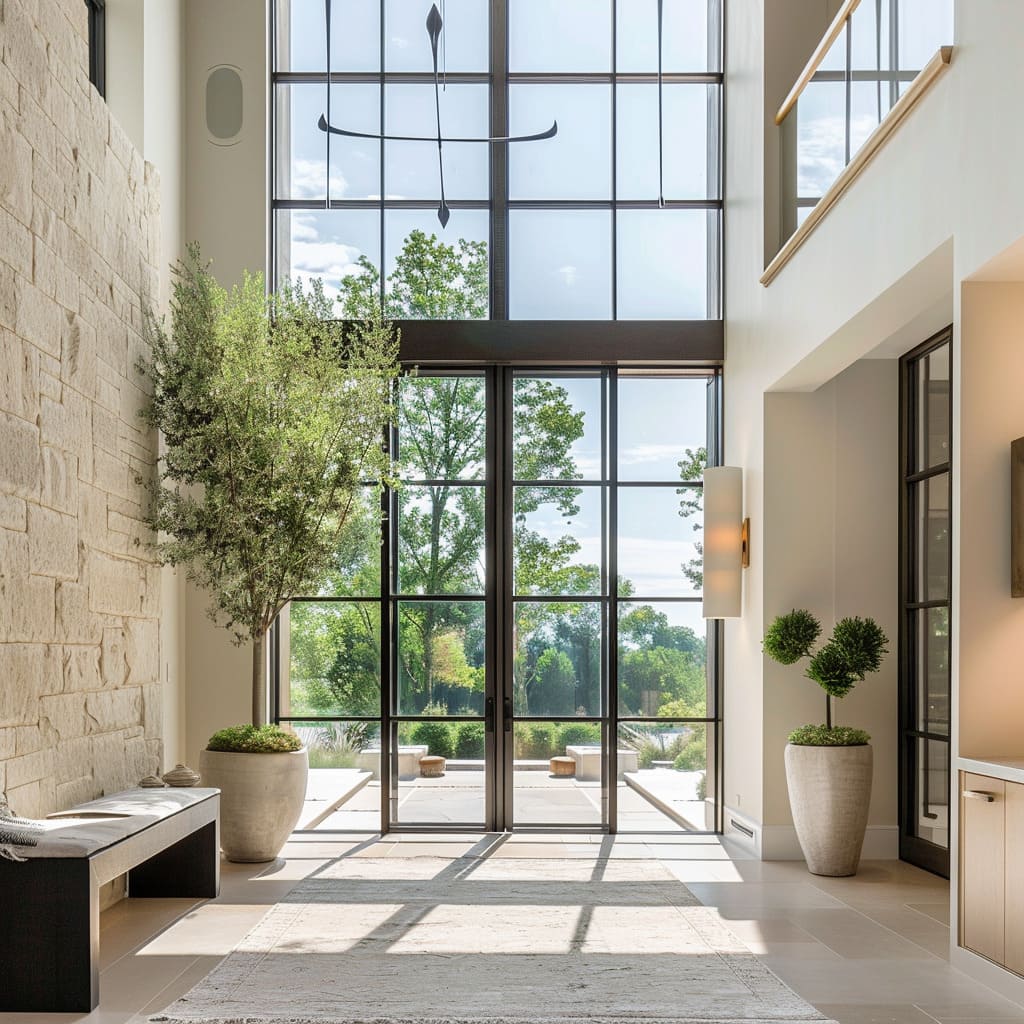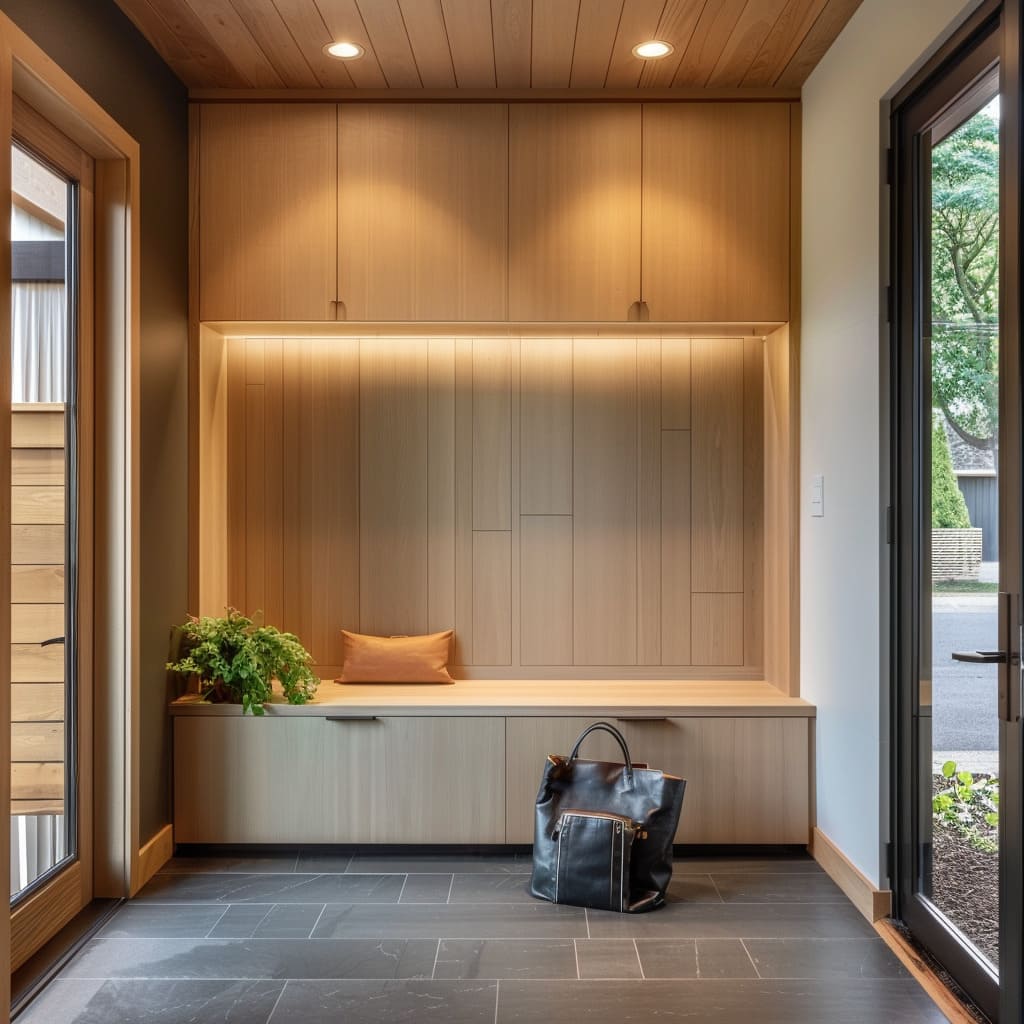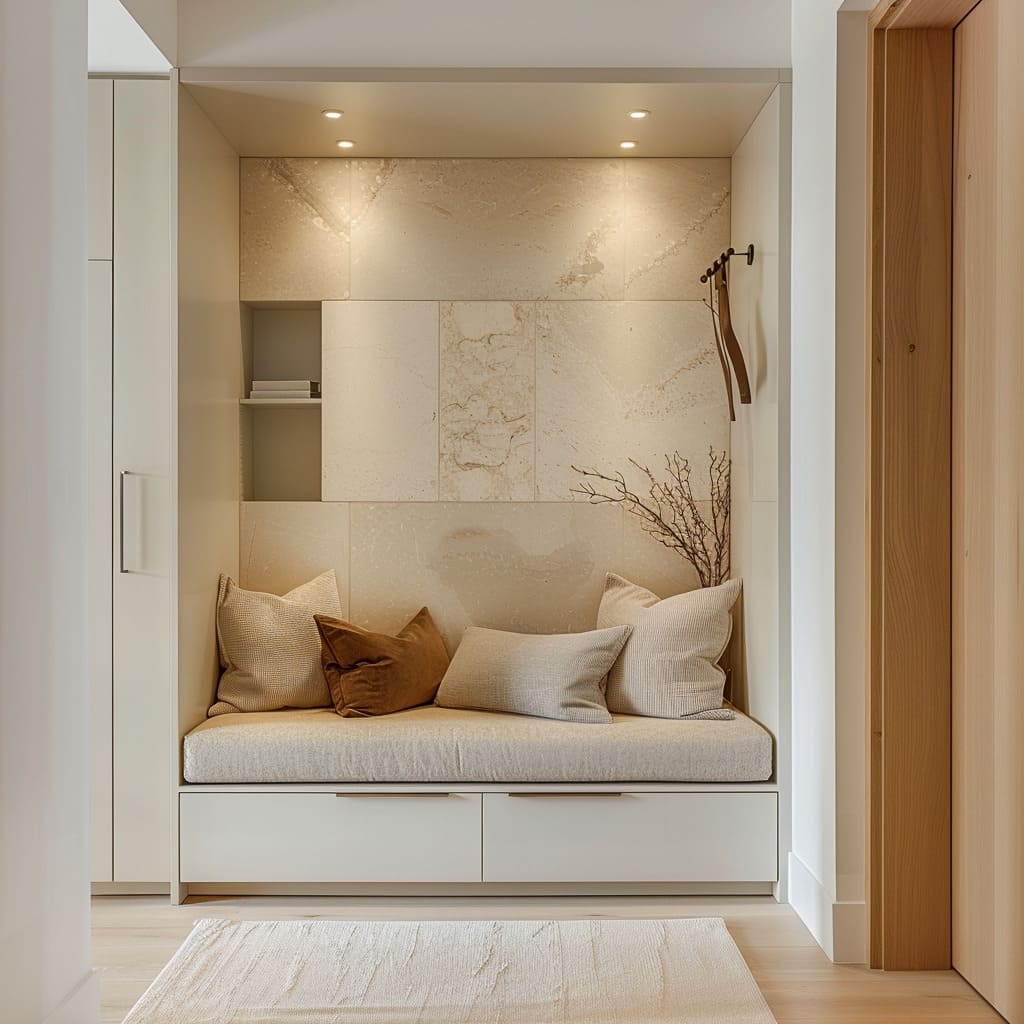Overview of Scandinavian Design
The essence of Scandinavian design lies in its focus on simplicity, functionality, and a deep appreciation for natural elements. Originating in the Nordic countries, this design style embraces the philosophy of less is more, where each element in a space is carefully chosen for its purpose and beauty.
Scandinavian design avoids clutter and unnecessary ornamentation, instead opting for clean lines, light color palettes, and materials that bring a sense of warmth and connection to nature. The result is an environment that feels open, calm, and highly practical, making it an ideal approach for an entryway, which serves as the first and often most impactful impression of a home
Importance of the Entryway
The entryway is the first space guests and homeowners encounter upon entering a home. It sets the tone for the entire house and offers a glimpse into the overall design aesthetic.
A well-designed entryway not only welcomes guests but also provides practical functions like storage and seating. In Scandinavian design, the entryway is more than just a transitional space; it is a carefully crafted area that balances beauty with utility.
By thoughtfully incorporating Scandinavian principles into your entryway, you can create a welcoming and efficient space that reflects the simplicity and elegance of your home’s interior
Design and Layout
High Ceilings and Open Space
High ceilings are a hallmark of grand design, and when paired with the clean, minimalist lines of Scandinavian style, they create an entryway that feels both expansive and inviting. The use of high ceilings in an entryway allows for the incorporation of large windows, which draw in natural light and emphasize the room’s vertical space.
This design choice not only enhances the aesthetic appeal but also creates a sense of openness and airiness that is both refreshing and comforting. The open space is further accentuated by the careful placement of furniture and decor, which are kept to a minimum to avoid visual clutter.
This approach allows the natural architecture of the space to shine, creating an environment that is as functional as it is beautiful
High ceilings, when paired with large windows, allow for an abundance of natural light to flood the entryway, emphasizing the vertical space and creating a sense of expansiveness. This natural light enhances the aesthetic appeal by illuminating the clean, minimalist lines of Scandinavian design, making the space feel both open and inviting.
The minimalist placement of furniture and decor plays a crucial role in maintaining the openness of the entryway. By keeping these elements to a minimum, visual clutter is avoided, allowing the architectural features, such as the high ceilings and large windows, to be the focal points of the space.
The design choice of high ceilings and open space aligns with Scandinavian style principles by focusing on simplicity and functionality. The airy and expansive feel of the space, created by the combination of high ceilings, large windows, and minimal decor, reflects the Scandinavian emphasis on clean lines, natural light, and an uncluttered environment
Maximizing Natural Light
Natural light contributes to a warm and welcoming atmosphere in a Scandinavian-style entryway by illuminating the space and highlighting the natural materials and minimalist design elements. The influx of daylight creates an inviting environment that feels both open and airy, which is central to Scandinavian design
In spaces where large windows are not possible, alternative methods to maximize natural light include using light-colored walls, strategically placing mirrors to reflect light, and incorporating transparent or sheer window treatments. These approaches help to brighten the space and maintain the desired connection to the outdoors
Light tones on walls, floors, and furnishings enhance the effect of natural light by reflecting it throughout the space, making the entryway feel larger and more open. This careful selection of light colors amplifies the brightness of the room, further reinforcing the airy and serene ambiance typical of Scandinavian design
Compact and Efficient Layouts
Not all homes have the luxury of expansive entryways with high ceilings. In more compact spaces, the principles of Scandinavian design are equally effective.
The key is to maximize the efficiency of the space while maintaining a sense of openness and simplicity.
Built-in storage solutions, such as cabinetry or seating with hidden compartments, are essential in these environments. These elements provide the necessary functionality without sacrificing the clean lines and uncluttered look that are central to Scandinavian design.
The use of light, neutral colors on the walls and floors can make smaller entryways feel more spacious, while carefully chosen decor elements add personality without overwhelming the space
Natural Stone Elements
The use of natural stone in an entryway contributes to the cohesive and luxurious feel of Scandinavian design by adding a sense of permanence and timeless beauty. The natural textures and subtle variations in stone create a unified aesthetic that enhances the overall elegance of the space
Light-colored stones like limestone, travertine, or marble are preferred in Scandinavian interiors because of their ability to reflect light, maintaining the bright and open atmosphere that is characteristic of this design style. These stones help to amplify natural light, making the space feel more expansive and airy
The finish of the stone, whether polished or honed, plays a significant role in complementing the other materials in a Scandinavian entryway. A polished finish can add a refined, luxurious quality, while a honed finish introduces a softer, more rustic texture.
Both finishes ensure that the stone harmonizes with the surrounding materials, creating a balanced and cohesive look
Warm Wood Accents
Wood is an essential material in Scandinavian design, used extensively for its warmth and natural beauty. In an entryway, wood accents can be found in flooring, cabinetry, and even ceiling treatments.
The use of wood adds a tactile quality to the space, balancing the coolness of natural stone with its rich, organic texture. Light woods such as oak, birch, or ash are commonly used to maintain the airy, bright aesthetic.
These materials are often left in their natural state or treated with a light stain to enhance their grain without darkening their color. The result is a space that feels warm, inviting, and connected to nature, embodying the essence of Scandinavian design
Marble and Limestone Features
Marble and limestone are often incorporated as feature elements in Scandinavian entryways, adding a touch of sophistication and elegance. These materials are typically used for countertops, accent walls, or decorative details, where their distinctive veining and subtle color variations can be fully appreciated.
Marble, with its smooth, polished surface, brings a refined, luxurious quality to the space, while limestone, with its softer, more rustic appearance, adds a sense of groundedness and connection to the earth. Both materials are chosen for their ability to complement the minimalist, natural aesthetic of Scandinavian design, offering a subtle contrast to the warm wood tones and light-colored walls
Built-In Cabinetry and Storage
Efficient storage is a key component of Scandinavian design, and nowhere is this more important than in the entryway. Built-in cabinetry offers a streamlined solution that maximizes storage without disrupting the clean lines of the space.
These cabinets are often designed with integrated handles and minimalist hardware, blending seamlessly with the surrounding walls. The interior of the cabinets can be customized to suit the needs of the household, with options for hanging coats, storing shoes, or organizing everyday essentials.
The exterior is typically finished in the same light wood or neutral tones as the rest of the entryway, maintaining a cohesive and harmonious appearance
Benches and Seating
Integrating seating into the design as a built-in bench significantly enhances both the functionality and aesthetics of a Scandinavian entryway. By incorporating a built-in bench, the design allows for a practical and convenient spot for sitting while putting on or removing shoes, which is essential in any entryway.
Additionally, the built-in bench often includes storage compartments beneath the seat, providing a discreet and efficient solution for storing items like shoes, bags, or seasonal accessories. This dual-purpose design maximizes the use of space, which is particularly important in smaller or more compact entryways, ensuring that the area remains organized and free from clutter
The aesthetic appeal of a built-in bench in a Scandinavian entryway is equally important. By seamlessly integrating the bench into the overall design, it maintains the clean, minimalist lines that are characteristic of Scandinavian style.
The bench is typically upholstered in a neutral fabric that complements the room’s color scheme, adding comfort without drawing attention away from the simplicity and elegance of the design.
The use of natural materials, such as wood, in the bench construction further enhances the warmth and inviting feel of the entryway, making it a welcoming space for both residents and guests. The built-in bench embodies the Scandinavian principles of simplicity, functionality, and a connection to natural elements, making it an ideal addition to any entryway designed in this style
The bench in a Scandinavian entryway is typically upholstered in a neutral fabric to align with the design’s emphasis on simplicity, functionality, and subtle elegance. Neutral fabrics, such as shades of grey, beige, or white, blend seamlessly with the overall color palette of the space, which often features light and airy tones.
This choice helps maintain the minimalist aesthetic that is central to Scandinavian design, ensuring that the bench does not become a focal point but rather complements the surrounding elements
The use of neutral fabric also contributes to the sense of calm and serenity that Scandinavian interiors aim to create. By avoiding bold or contrasting colors, the bench enhances the cohesive and harmonious feel of the entryway.
This choice allows the natural beauty of the materials, such as wood or stone, to stand out, while the bench itself provides comfort and practicality without overwhelming the space. The understated elegance of neutral upholstery reinforces the overall design principles of Scandinavian style, creating a welcoming and balanced environment
Smart Storage Solutions
In addition to built-in cabinetry, Scandinavian entryways often incorporate other smart storage solutions to keep the space organized and functional. Wall-mounted hooks or racks provide a place to hang coats, hats, and bags, while open shelves offer a spot for decorative items or everyday essentials.
Shoe cabinets with ventilated doors are a popular choice, keeping footwear neatly tucked away while allowing air to circulate. These storage solutions are designed to be both practical and aesthetically pleasing, ensuring that the entryway remains uncluttered and easy to use
Decorative Elements
Incorporating Greenery
Bringing elements of nature indoors is a fundamental aspect of Scandinavian design, and greenery plays a significant role in achieving this connection. Potted plants, such as olive trees or ferns, are commonly used to add life and color to the entryway.
These plants are often housed in simple, textured pots that complement the natural materials used elsewhere in the space.
The greenery not only enhances the aesthetic appeal of the entryway but also contributes to a sense of well-being and calm. The placement of the plants is carefully considered, with larger plants often positioned in corners or near windows to take advantage of natural light, while smaller plants are used to add interest to shelves or tabletops
Art and Sculptural Pieces
While Scandinavian design is known for its minimalism, there is always room for carefully chosen decorative elements that add personality and interest to the space. Modern art and sculptural pieces are often used to enhance the visual appeal of an entryway, providing focal points that draw the eye without overwhelming the room.
These pieces are typically understated and harmonious with the overall design, often featuring simple forms and natural materials. The placement of art and sculptures is strategic, with items displayed on walls, shelves, or pedestals where they can be appreciated without cluttering the space
Textured Accents and Rugs
The addition of textured accents, such as rugs and throw pillows, is an effective way to add warmth and comfort to a Scandinavian entryway. Rugs are often chosen for their soft, neutral tones and subtle patterns, which complement the natural materials used in the space.
A well-placed rug can soften the hard surfaces of stone or wood flooring, making the entryway feel more inviting and comfortable. Similarly, throw pillows in muted colors and natural fabrics can be used to enhance the coziness of bench seating, adding a layer of comfort without detracting from the minimalist design
Lighting Design
Natural and Artificial Lighting
Lighting is a critical element in Scandinavian design, with a strong emphasis on maximizing natural light. Large windows are often a feature of Scandinavian entryways, allowing daylight to flood the space and highlight the natural beauty of the materials used.
In the absence of abundant natural light, artificial lighting is carefully selected to create a warm and inviting ambiance. Recessed ceiling lights provide even, unobtrusive illumination, while strategically placed pendant lights add character and style.
The goal is to create a well-lit environment that feels both bright and welcoming, regardless of the time of day
Accent and Feature Lighting
In addition to general lighting, accent lighting is used to highlight specific features within the entryway. Wall sconces, for example, can be positioned to draw attention to a piece of art or a textured wall, while under-cabinet lighting can be used to illuminate storage areas or seating.
Pendant lights with sleek, modern designs are often suspended from high ceilings, providing focused lighting while adding a sculptural element to the space. These lighting choices are both functional and decorative, contributing to the overall aesthetic while ensuring that the entryway is well-lit and easy to navigate
Color Palette and Finishing Touches
Neutral and Calming Tones
The color palette of a Scandinavian entryway is deliberately chosen to create a calming and harmonious environment. Soft whites, light beiges, and gentle greys dominate the space, providing a neutral backdrop that allows the natural materials and textures to stand out.
These colors are not only visually soothing but also help to enhance the sense of space and light, making the entryway feel larger and more open. The consistency of the color palette is key to maintaining the minimalist aesthetic, with any additional colors introduced sparingly through decor items or artwork
Subtle Metallic Accents
While the focus of Scandinavian design is often on natural materials, subtle metallic accents can be introduced to add a touch of modern sophistication. Handles, light fixtures, and hardware in brushed metal or matte black finishes provide contrast and interest without overpowering the space.
These accents are carefully chosen to complement the overall design, adding a sleek, contemporary edge that enhances the minimalist aesthetic. The use of metallic elements should be restrained, ensuring that they enhance rather than dominate the natural beauty of the entryway
Personalizing the Space
Despite its minimalist principles, Scandinavian design allows for personalization through carefully selected decor items. Personal touches, such as family photos, cherished mementos, or unique art pieces, can be integrated into the entryway without disrupting the clean lines and uncluttered feel.
The key is to choose items that complement the natural materials and color palette, ensuring that they blend seamlessly with the overall design. By thoughtfully incorporating personal elements, the entryway can reflect the individuality of the homeowner while maintaining the serene and cohesive aesthetic of Scandinavian design
Case Studies and Real-Life Examples
Large Scandinavian Entryways with High Ceilings
In homes with the luxury of space, large entryways with high ceilings offer the perfect canvas for Scandinavian design. These entryways often feature expansive windows that draw in natural light, enhancing the open, airy feel of the space.
The use of natural materials, such as stone floors and wood paneling, is complemented by minimalist furniture and decor, creating an environment that feels both grand and welcoming. Case studies of such entryways can provide inspiration for homeowners looking to achieve a similar look, highlighting the importance of scale, proportion, and material choice in creating a successful design
Compact and Cozy Scandinavian Entryways
For those working with smaller spaces, the principles of Scandinavian design can be applied to create a compact yet cozy entryway. Smart storage solutions, such as built-in benches with hidden compartments or wall-mounted hooks, are essential in these environments.
The use of light colors and reflective surfaces can make the space feel larger, while carefully chosen decor adds personality without cluttering the room. Examples of compact entryways can demonstrate how even the smallest spaces can be transformed into functional and stylish areas that set the tone for the rest of the home
Incorporating Natural Elements in Urban Settings
Urban homes, such as those in New York or Boston, may present unique challenges when it comes to incorporating natural elements into the entryway. Limited access to natural light or outdoor space can make it difficult to achieve the bright, airy feel that is characteristic of Scandinavian design.
However, by using light-colored walls, natural materials, and strategically placed greenery, it is possible to create a connection to nature even in the heart of the city. Case studies of urban Scandinavian entryways can provide practical solutions and inspiration for homeowners looking to bring the tranquility of nature into their urban environments
Conclusion
Recap of Key Elements
In creating a Scandinavian entryway, the key elements to focus on are simplicity, functionality, and a connection to nature. The use of natural materials, such as wood and stone, combined with a neutral color palette, creates a calm and cohesive environment that is both welcoming and practical.
By maximizing natural light, incorporating smart storage solutions, and carefully selecting decor items, you can create an entryway that reflects the beauty and serenity of Scandinavian design









































